Join More Than 50,000+ Subscribers and get latest camera news and rumors
NEW CAMERA VIDEOS ON YOUTUBE
|
By admin, on February 19th, 2015
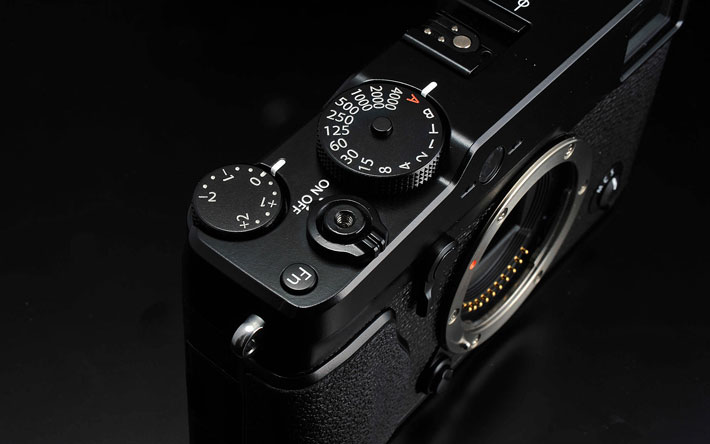
The X-Pro2 specification collected by Spanish site dslrmagazine from an talk with the Fuji Manager at the CP+ in Japan. So don’t consider this as rumor its almost a confirmed report….
Fujifilm X-Pro 2 rumored specification
- The X-Pro2 will arrive with Hybrid Viewfinder
- More Compact design compared to the current X-Pro 1
- X-PRO2 may feature new generation X-trans CMOS sensor
No more X-M camera is coming., the X-M line is dead now, Fuji will only carry forward the X-A line of entry level mirrorless camera.
STAY WITH ON FACEBOOK | TWITTER | GOOGLE+ to get live news Fujifilm Rumor
src – Fujirumor.com
By admin, on February 18th, 2015
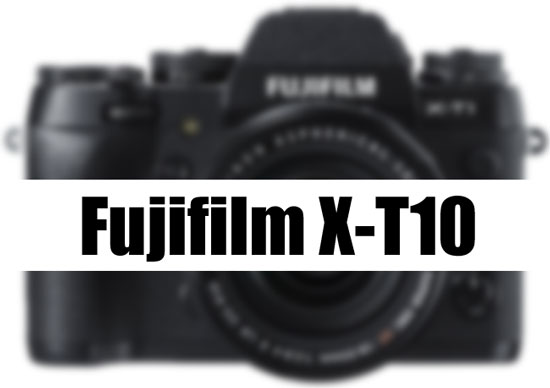 According to the latest rumors surfaced over the web, Fujifilm may soon announce a X-T10 camera, the camera will be a affordable version of the X-T1 camera, no specification of the X-T10 available yet, but we do also believe that no New X-Trans sensor is expected to arrive with the entry level model. According to the latest rumors surfaced over the web, Fujifilm may soon announce a X-T10 camera, the camera will be a affordable version of the X-T1 camera, no specification of the X-T10 available yet, but we do also believe that no New X-Trans sensor is expected to arrive with the entry level model.
STAY WITH ON FACEBOOK | TWITTER | GOOGLE+ to get live news Fujifilm Rumor
src – FR.com
By admin, on February 12th, 2015
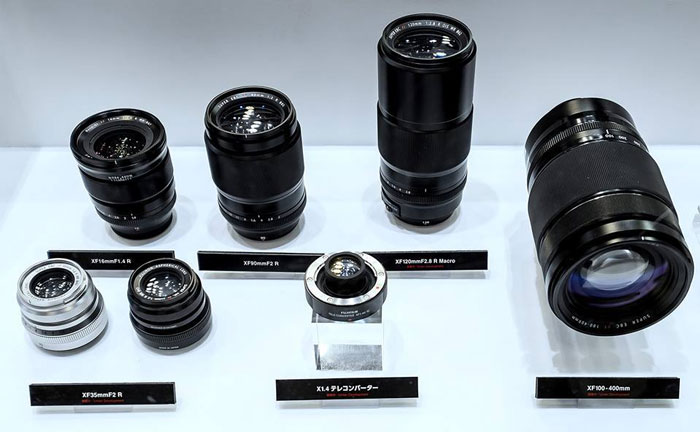
So finally after a long break Fuji have something new and innovative to show at CP+ show, Fuji will be releasing a total of 5 new lenses and 1 tele-converter, take a look at the list of lenses and below
– XF 16mmF1.4, WR & Clutch mechanism – filter 67mm
– XF 35mmF2, WR – filter 43mm
– XF 90mmF2
– XF 120mmF2.8 macro : focus-limiter, WR & OIS (!!!) – filter 62mm
– XF 100-400 : can’t read any information
– teleconverter : shape is limitating for using with most X-lenses (not a surprise)
Lens Images after the break…
Continue reading Images of Upcoming Fuji Lenses Images Leaked – CP+ Show 2015
By admin, on January 19th, 2015

Fujifilm X-A vs X-A1, before we start I must say that Fuji X-A1 users that don’t waste your money in updating your camera… now look at the table carefully… and spot the difference..
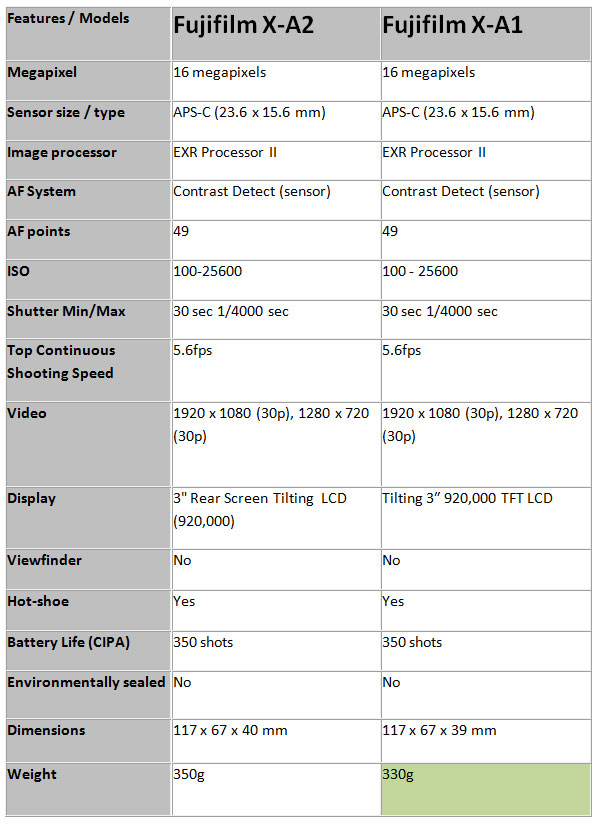
Both the camera shares same sensor, image processor, AF system, and even the display remains same.
There is no major difference between the core specification of both the camera, actually Fuji should explain briefly why did they announced the X-A2 camera.
Click here to buy Fujifilm X-A2 from Amazon | B&H Store
By admin, on January 15th, 2015

Fujifilm finally announced the XQ2 premium compact camera with 12 X-Trans II sensor by having the same resolution as of its predecessor, the XQ1 was having X Trans sensor.. so we do hope to see some improvement over the AF speed and ISO low-light performance of the camera.
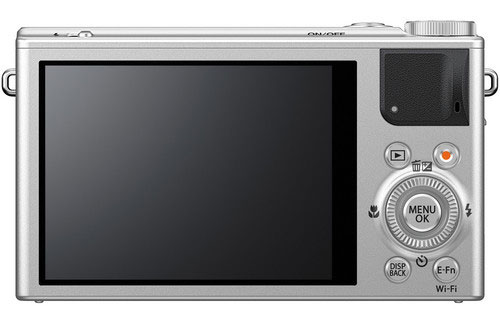 The camera features Fujinon 4x Optical Zoom f/1.8-4.9 Lens, the ISO range varies from 100-12800, the camera can also record Full HD videos and features built-in WiFi connectivity, the camera also features a customizable control ring along side of the lens for quickly adjusting your desired settings. The camera features Fujinon 4x Optical Zoom f/1.8-4.9 Lens, the ISO range varies from 100-12800, the camera can also record Full HD videos and features built-in WiFi connectivity, the camera also features a customizable control ring along side of the lens for quickly adjusting your desired settings.
The XQ2 will be available in black, silver, and white in February for $399.95.
You can buy the XQ2 camera from Amazon || B&H
Fujifilm announces the XQ2 – a super-compact and ultra-lightweight premium X Series camera
FUJIFILM Corporation (President: Shigehiro Nakajima) is proud to announce the launch of the new FUJIFILM XQ2, the smallest camera in the premium X Series range.
The XQ2 is a deceptively powerful camera offering advanced X Series image quality and functionality in a very small package. Suited to both amateurs and enthusiasts, the XQ2 is compact enough to carry with you at all times, captures superb shots and offers plenty of creative effects.
- The pocket-sized XQ2 features a versatile F1.8 4x zoom lens alongside many features seen on the recently-launched and highly regarded FUJIFILM X30, including the same 2/3-inch X-Trans™* CMOS II sensor, EXR Processor II, highly-evolved AF and new “Classic Chrome” Film Simulation mode.
- At 2/3-inch, the XQ2’s sensor is approximately double** the size of those found in ordinary compact digital cameras and also able to deliver the world’s fastest*** AF speed at just 0.06 seconds.
- At an ultra-slim 100×58.5×33.3mm (WxHxD) it’s also one of the most pocketable advanced cameras around, but there’s no compromise on performance or image quality. What’s more, the XQ2’s elegant design and classy finish really makes it stand out. Available in luxurious black, silver or white finishes, it is the perfect premium compact for discerning photographers.
Unique sensor design and X Series image quality
The XQ2’s 2/3-inch X-Trans™ CMOS II sensor has a unique, random pixel array which controls moiré and false colors without the need for an optical low-pass filter. This enables light from the lens to pass straight to the sensor delivering excellent resolution and low noise.
Bright F1.8 lens
The ultra-bright lens on the XQ2 has a wide-angle maximum aperture of F1.8, and a 4x zoom (25-100mm*4) and constructed with four aspherical and three extra-low dispersion elements, with all lens surfaces covered in Fujinon’s unique HT-EBC coating to reduce flare and ghosting. The bright F1.8 aperture allows a natural bokeh effect in the background, creating a beautiful contrast with the main subject, and the lens’s 3.0 stop*5 optical image stabilization keeps pictures sharper when using the camera in low-light conditions.
In addition, Fujifilm’s unique “Lens Modulation Optimizer” image processing technology maximizes lens performance by correcting optical effects like diffraction, based on the unique light-gathering performance and characteristics of each lens setting.
Speedy and responsive shooting
With its instinctive focusing and quick start-up time, the XQ2 won’t let you down when you need to capture a fleeting moment. It boasts the world’s fastest AF of just 0.06 seconds and a shooting interval of 0.3 seconds until the next shot can be taken, while shutter lag is an almost unnoticeable 0.015 seconds.
Using an evolved algorithm to boost performance, the AF system examines each subject and scene, and automatically switches between Contrast AF mode, which is accurate even in low light, and Phase Detection AF mode, which is faster for shooting moving subjects. This ensures speedy and accurate autofocus for any type of scene or subject. The new Multi AF automatically selects up to nine focus areas for accurate focusing across the frame and the ability to detect human faces enhances AF accuracy even further.
Easy operation and great handling
The premium finish of the camera body and its ease of operation give the XQ2 a truly sophisticated feel. From its Advanced Filters to manual focusing, or setting the aperture and shutter speed, a variety of functions can be set by turning the control ring, textured and machined aluminum, fitted around the lens. This tactile control avoids the need to go into the menu and speeds up operation, plus it’s easy to access your own preferred functions, using the extended function (E-Fn) button on the back of the camera.
Transfer images wirelessly
Wireless image transfer is simple from the XQ2 to a smartphone or tablet once the free FUJIFILM Camera Application has been installed. There are no troublesome ID and password settings; just press the Wi-Fi®*6 button on the camera and instantly add the images to your blog or share them with friends via social networking sites. Users can also set the XQ2 to read its location from smartphones and tablets, enabling them to keep a record of where they took their shots. Wi-Fi transfer also enables wireless backup of photos and movies onto your computer*7 and printing is easy, too – just send images to an Instax SHARE Smartphone Printer SP-1 for Instax instant film prints.
Focus and review in comfort
The XQ2’s 3.0-inch 920K-dot LCD makes viewing easy, even in bright conditions thanks to its high-contrast, anti-reflective glass and 85° vertical and horizontal viewing angles. The LCD also helps users achieve critically sharp shots when using manual focus, thanks to its Focus Peak Highlight mode, where in-focus areas of the subject can be instantly recognized by a high-contrast outline.
Perfect colors and creative options
Fujifilm’s unprecedented image quality has been cultivated through the development of photographic films over the past 80 years, reproducing warm skin tones, bright blue skies and rich greens in trees and grass, just as photographers remember the scene. Building on this extensive expertise, the XQ2 features the new, “Classic Chrome” Film Simulation mode, which delivers muted tones and deep color reproduction. Classic Chrome is just one of nine different modes that simulate the effects of traditional Fujifilm films, including color reversal film effects (Velvia / PROVIA / ASTIA), monochrome filters (MONOCHROME, Ye filter, R filter and G filter) and SEPIA.
Providing additional creative options, the XQ2 features eight Advanced Filter functions:
Pop Color – Emphasizes contrast and color saturation
Toy Camera – Creates shaded borders as if you were taking a photo on a toy camera
Miniature – Adds top and bottom blur for a diorama or miniature effect
Dynamic Tone – Creates a fantasy effect by boosting tones
Partial Color – Retains one selected original color and changes the rest of the photo to black & white. Colors can be selected from red, orange, yellow, green, blue and purple High Key – Enhances brightness and reduces contrast to lighten tonal reproduction
Low Key – Creates uniformly dark tones with few areas of emphasized highlights
Soft Focus – Creates a look that is soft throughout the whole image
A separate Multiple Exposure function offers users the chance to combine two separate subjects into one photo. For further creative control, the camera’s aspect ratio can be switched between 4:3, 3:2, 16:9, and 1:1 (square) to accommodate a wide range of photographic styles. The XQ2 also features an ADVANCED SR AUTO mode, which recognizes faces and scene types, letting users shoot everything from portraits to landscapes and even moving subjects while the XQ2 optimizes the focus, exposure, ISO and other settings.
Intelligent flash
The built-in Super Intelligent Flash accurately controls the flash power required for any shooting situation, so natural-looking indoor portraits, macro subjects, or food images can all be taken while over-exposure is carefully controlled. The same function means that strongly backlit subjects, like portraits, will also be beautifully and naturally illuminated bringing out all the detail you want from shadow areas.
Process RAWs on the move
Through the in-camera RAW development function, a RAW image can be converted to JPEG without the need for additional software and a computer.
Shoot HD Movies
Movies can be filmed in Full HD at 60fps and the dedicated image stabilization function helps keep videos smooth when shooting handheld. If you want to explore the movie director in you, then try out the Film Simulation Modes to give your videos a distinctive and creative look.
- * “X-Trans” is a trademark or registered trademark of FUJIFILM Corporation
- ** Compared with a 1/2.3-inch sensor. Approximately 1.3 times of a 1 /1.7-inch sensor
- *** Fujifilm research as of December 2014. Compared with other digital cameras equipped with 2/3-inch sensor or larger, based on CIPA standards, and conducted in High Performance mode.
- *4 35mm format equivalent.
- *5 CIPA standards.
- *6 Wi-Fi® is a registered trademark of the Wi-Fi Alliance.
- *7 This function requires installation of the free application software FUJIFILM PC AutoSave in your personal computer.
FUJIFILM XQ2 Key features list:
- Ultra-pocketable X-series premium compact size
- 12 megapixel 2/3inch X-Trans CMOS II sensor
- Original color filter array to control moiré and false color without an optical low pass filter
- EXR Processor II
- F1.8-F4.9 4x optical zoom lens (equivalent to 25-100mm in 35mm format)
- 4x intelligent digital zoom (16X combined with optical zoom)
- Lens Modulation Optimizer for improved image quality
- Wireless transfer of images using FUJIFILM Camera Application app
- 3-inch 920K-dot premium LCD with 85°vertical and horizontal viewing angle
- In-camera RAW converter
- ISO100 – 12800
- Built-in Super Intelligent Flash
- Advanced Creative functions:
- Nine Film Simulation modes: PROVIA, Velvia, ASTIA, CLASSIC CHROME, MONOCHROME, Ye filter, R filter and G filter, and Sepia
- Eight Advanced Filter effects: Toy Camera, Miniature, Dynamic Tone, Pop Color, Soft Focus, High Key, Low Key, and Partial Color
- Full HD Movie mode
Available Accessories
- Bottom leather case (Black BLC-XQ1 BC and Brown BLC-XQ1 BW)
- Waterproof case WP-XQ1 for depth to 40 meters
- O Ring Kit ORK-XQ1
Fuji XQ2 Major Specification
- 12MP 2/3″ X-Trans CMOS II Sensor
- EXR Processor II
- Fujinon 4x Optical Zoom f/1.8-4.9 Lens
- 25-100mm (35mm Equivalent)
- 3.0″ 920k-Dot LCD Monitor
- Full HD 1080p Video with Stereo Sound
- Built-In Wi-Fi Connectivity
- Over 100,000 Phase-Detection AF Pixels
- ISO 12800 and Image Stabilization
- Lens Modulation Optimizer
Click here to download Fujifilm XQ2 specifications
By admin, on January 15th, 2015
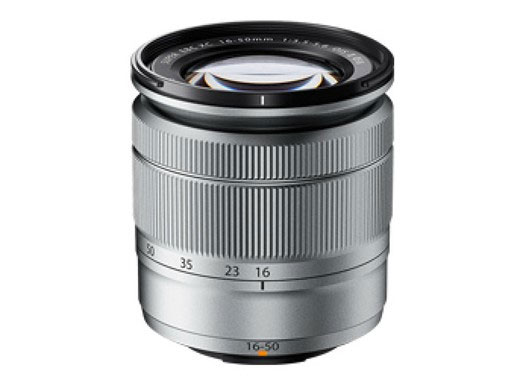
Fujifilm announced new X-A2 camera today along with the new improved kit lens, the lens features improved optics and closer focusing distance of 15cm, better than its predecessor by having 30cm of minimum focusing distance.
Click here to buy Fujifilm X-A2 with 16-50mm kit lens from Amazon | B&H Store
FUJINON XC16-50mm II (24-76mm) F3.5-5.6 OIS
- 24-76mm equivalent F3.5-5.6 lens
- Fully compatible with FUJIFILM X-Mount
- 12 all glass elements in 10 groups including 3 aspherical elements and 1 ED element
- Seven round-edged aperture blades, which offer 17 stops in 1/3 EV steps
The newly announced zoom lens is equivalent to 76-350mm, the specification look quite similar to the first generation of zoom lens except one thing, introduction of Precision Stepping AF Motor for silent AF operation exclusively designed for video purpose.
Click here to see or buy the new XC50-230mm II – Amazon or B&H
FUJINON XC50-230mm II (76-350mm) F4.5-6.7 OIS
- 76-350mm equivalent F4.5-6.7 lens
- Fully compatible with FUJIFILM X-Mount
- 13 all glass elements in 10 groups including 1 aspherical lens and 1 ED element
- Optical image stabilization that minimizes blur at longer focal lengths and in low light
- A precision stepping motor for high-speed autofocusing
By admin, on January 15th, 2015
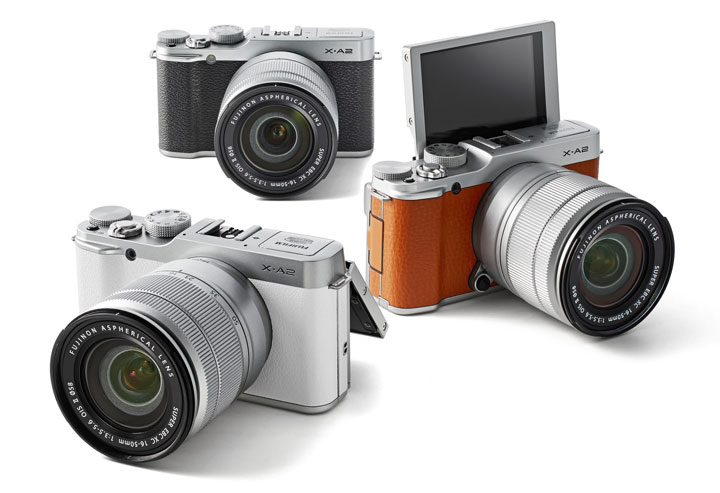
The long rumored Fuji X-A2 camera finally announced today the camera features 16.3MP APS-C CMOS Sensor, EXR II image processor, the ISO can be boosted up to 25600, the camera also comes with built in WiFi connectivity and on the rear side we have 3.0″ 920k-Dot 175° Tilting LCD, so with the 175° of movement you can easily capture your selfies.
The camera also bundled with new lens, the Fujinon XC 16-50mm f/3.5-5.6 OIS II Lens.. the lens features improved optics design and improved macro mode.
Click here to buy Fujifilm X-A2 from Amazon | B&H Store
Fujifilm X-A2 Press Release
Introducing the FUJIFILM X-A2
A premium interchangeable lens camera with 175° tilting LCD and new Eye Detection Auto Focus for perfect selfies!
FUJIFILM Corporation (President: Shigehiro Nakajima) has announced it will launch the FUJIFILM X-A2. Offering outstanding color reproduction, enhanced autofocusing and superb resolution, the X-A2 makes it easier than ever before for photographers to get the premium image quality that’s become synonymous with Fujifilm’s X Series.
The X-A2 features Fujifilm’s newly developed Eye Detection AF, Auto Macro AF and Multi-Target “MULTI AF” for fast and accurate autofocusing. It’s also the first X Series model to sport a 175-degree tilting LCD making it easier to take selfies and it comes with the new XC16-50mm F3.5-5.6 OIS II kit lens, which has a class-leading minimum working distance of 15cm (approx. 7cm from the edge of the lens) for macro photography.
Key new* features in the X-A2
Eye Detection AF, Auto Macro AF and Multi-Target “MULTI AF”
The camera features Eye Detection AF, Auto Macro AF and Multi-Target “MULTI AF”, which adjust autofocus settings according to the subject. This makes it easier to photograph diverse subject matter.
- Premium quality self-portraits with the 175° tilting LCD
The X-A2 is the first X Series model to sport a 175° tilting LCD for higher quality self-portraits, or selfies. Rotating the tilting LCD by 175° activates the new Eye Detection AF, which automatically focuses on the subject’s eyes. This allows you to shoot self-portraits that make the most of the famed X Series image quality, with an emphasis on reproducing even and smooth skin tones.
- All-new kit lenses with a minimum working distance of 15cm for macro photography
Fujifilm has developed two new kit lenses – the XC16-50mm F3.5-5.6 OIS II and XC50-230mm F4.5-6.7 OIS II – which feature an updated design and improved performance. The XC16-50mmF3.5-5.6 OIS II has a minimum working distance of 15cm (approx. 7cm from the front edge of the lens)**, the shortest in its class, for impressive close-up shooting. The XC50-230mm F4.5-6.7 OIS II offers optical image stabilization of approximately 3.5-stops***, making it easier to take hand-held telephoto and night images.
- The unique “CLASSIC CHROME” Film Simulation mode
Fujifilm’s newest Film Simulation mode, “CLASSIC CHROME”, has been added. With its deeper colors and richer tones, it increases the choice of color and tonal reproduction. Classic Chrome is highly popular and is great for those occasions when you want to create an image that tells a story.
Product features
(1) Outstanding photo quality and versatile creative functions using color reproduction technology 80 years in the making
- The large 16.3 megapixel APS-C sensor and the EXR Processor II image processing engine produce premium image quality despite the X-A2’s compact size. The sensor also delivers beautifully smooth bokeh effects for portraiture and macro shots when using a wide aperture.
- The image design technology, nurtured through the development of photographic films, delivers stunning color reproduction that’s unique to Fujifilm. Any scene can be captured beautifully just as the eye sees it, including the warm tones of human skin, clear blue skies and the red hues of the setting sun.
- The normal sensitivity range covers ISO200 to ISO6400, while extended sensitivity settings of ISO12800 and even ISO25600 can be selected when you want to minimize camera shake. The X-A2 produces clear images with astonishingly low noise, even on low-light nightscapes and indoor shots where high ISOs are essential.
(2) Now first-time users of interchangeable lens cameras can enjoy premium image quality
- The Mode Dial allows you to quickly select shooting modes. Advanced SR Auto mode determines the type of scene and automatically uses optimum shooting settings for high-quality images.
- The camera features Eye Detection AF, Auto Macro AF and Multi-Target “MULTI AF” modes so you can select the best option for your subject, while enjoying advanced AF performance including a shutter time lag of 0.05 seconds, a shooting interval of 0.4 seconds*4, and a start-up time of 0.5 seconds*5 so you never miss a shot.
- The use of two Command Dials means you only need a thumb to quickly adjust aperture, shutter speed and exposure settings. Frequently used functions such as white balance, continuous shooting and the self-timer can be assigned to standalone function buttons, eliminating the need to go through the Menu screen each time you need to change settings.
- *4 When the Live View is turned off.
- *5 When the Quick Start mode is turned on.
(3) 175-degree tilting high-definition LCD monitor enables creative shots from multiple angles
- The camera features a high-brightness and high-definition 3.0-inch 920,000-dot LCD monitor that has wide viewing-angle and can be tilted 175°. The feature is useful for shooting from a low-angle for children and pets, from a high-angle above large crowds or obstacles, or for capturing self-portraits.
- When the LCD is fully opened, the camera switches to the Eye Detection AF mode to capture high-quality selfies, sharply focusing on your eyes.
(4) Super Intelligent Flash optimizes light output according to individual scenes
The built-in Super Intelligent Flash accurately controls light output according to individual scenes. When shooting indoor portraits in low-light, small items or food, the flash system reduces highlight clipping to produce images exactly as your eyes see them. Natural colors and brightness are also achieved when shooting backlit scenes or photographing a person under intense sunlight that casts strong shadows on the face.
(5) A wide array of shooting modes: Film Simulation, Advanced Filters and Multiple Exposure
- The X-A2 features Fujifilm’s unique Film Simulation modes, which have been created using the knowledge amassed from over 80 years of film development. You can choose from six options: the true-to-life colors of PROVIA (standard), the vibrant tones and saturated colors of Velvia (vivid), the soft tones of ASTIA (soft) or the full-bodied colors and gentle shades of CLASSIC CHROME. Monochrome and Sepia modes are also available.
- The Advanced Filters functions allow you to add creative effects in camera. Choose from TOY CAMERA, MINITURE, DYNAMIC TONE, POP COLOR, SFOCUS, HIGH KEY, LOW KEY and PARTIAL COLOR.
- You can also combine two images into a single frame with the Multiple Exposure mode.
(6) Full HD movie shooting
The camera is capable of shooting full high-definition movies (30 frames per second), incorporating the color effects of Film Simulations and beautiful bokeh achieved with the combination of the large sensor and a wide aperture setting.
(7) Instant transfer of premium-quality X Series images to your mobile device and computer
- Download the free FUJIFILM Camera Application app to your smartphone or tablet*6 so you can transfer photos and videos to your device with a simple one-touch operation – no ID or password needed! It is also possible to view and select photos and videos in your camera and import them to your smart device.
- Images can also be sent directly from the camera to the Instax SHARE SP-1 smartphone printer for instant printing.
- The camera is Wi-Fi enabled*7 to easily back up in-camera data to your computer*8.
- It is also possible to geotag each image with location information, acquired through your smartphone or mobile device.
- *6 Android™ smartphones and tablets as well as iPhones and iPads
- *7 Wi-Fi® is a registered trademark of Wi-Fi Alliance.
- *8 The free FUJIFILM PC AutoSave software must be installed on your computer in advance.
(8) Available in two Perfect lens kits: A compact and lightweight standard zoom lens equivalent to 24mm*9 at the wide-angle end, and a telephoto zoom lens with focal lengths extending from 76mm*9 to 350mm*9
- The compact X-A2 is available in a kit with the XC16-50mm F3.5-5.6 OIS II standard zoom, which employs 12 all-glass elements in 10 groups, including 3 aspherical lens elements and 1 ED lens element. The lens uses seven rounded diaphragm blades to enable fine 1/3-step (17 steps in total) exposure control. Its lightweight focusing lens and high-precision motor achieve quick and silent autofocusing, while the minimum working distance of 15cm makes macro photography simple. The optical image stabilization function reduces camera shake in hand-held still images and videos.
- The double zoom lens kit also comes with the XC50-230mm F4.5-6.7 OIS II telephoto zoom, which employs 13 all-glass elements in 10 groups, including 1 aspherical lens element and 1 ED lens element. The lens offers an advanced optical performance across its focal range, producing clear images even when your subject is a long distance away. Its lightweight focusing lens and high-precision motor achieve quick and silent autofocusing. The optical image stabilzation.
Fujifilm X-A2 Major Specification
- 16.3MP APS-C CMOS Sensor
- EXR Processor II
- 3.0″ 920k-Dot 175° Tilting LCD
- Full HD 1080p Video Recording at 30 fps
- Built-In Wi-Fi Connectivity
- Eye AF, Auto Macro AF, Multi-Target AF
- Sensitivity to ISO 25600
- Q Menu Button and Super i-Flash
- Film Simulation and Multiple Exposure
- Fujinon XC 16-50mm f/3.5-5.6 OIS II Lens
Click here to Download Fujifilm X-A Full Specification
|
KEEP THIS BLOG ALIVE - Support New Camera Buy Canon Lenses, Buy Music CD or Digital Camera at amazon it helps this site, and you do not pay anything extra, it is just a way to help support this site.

|














